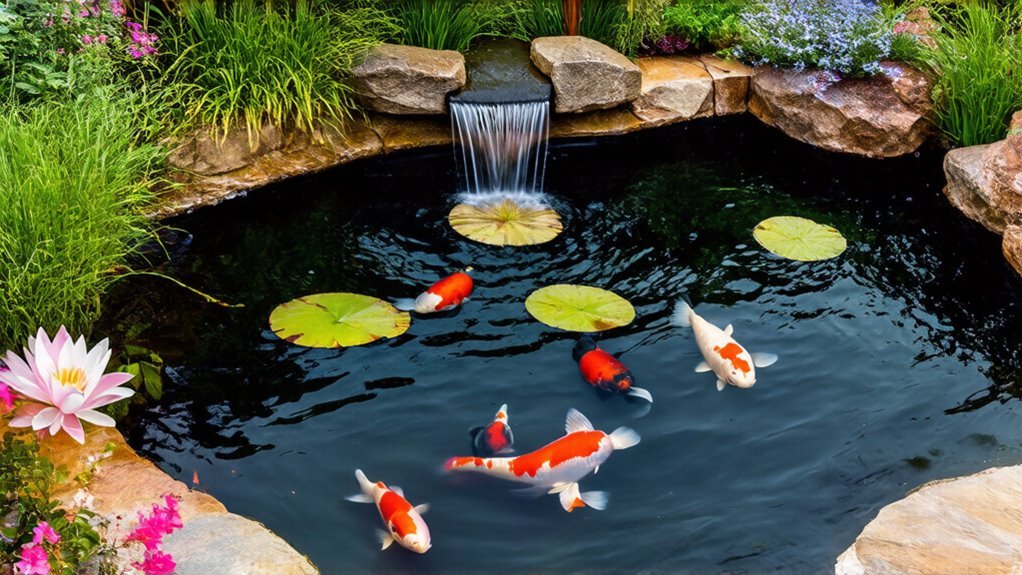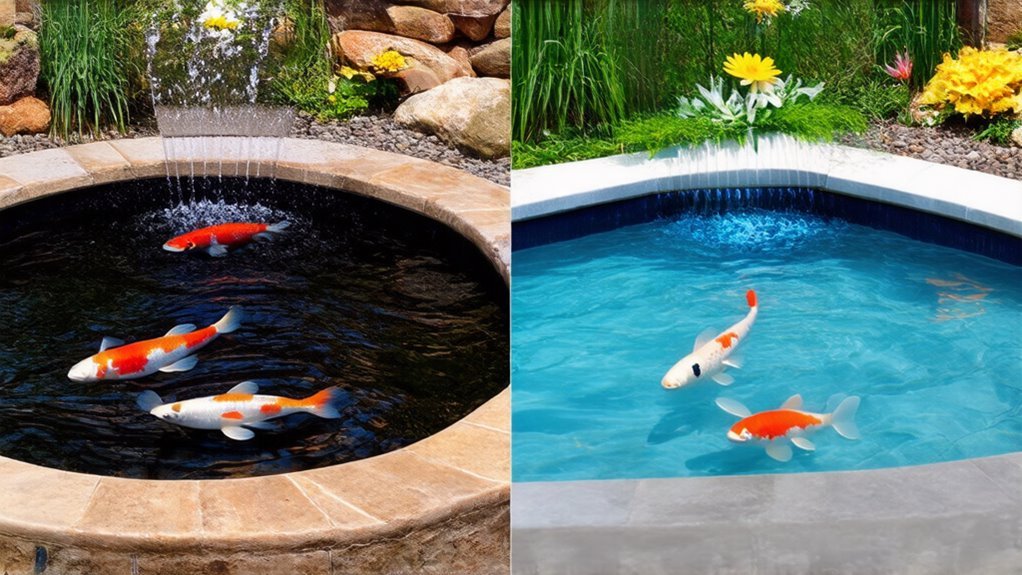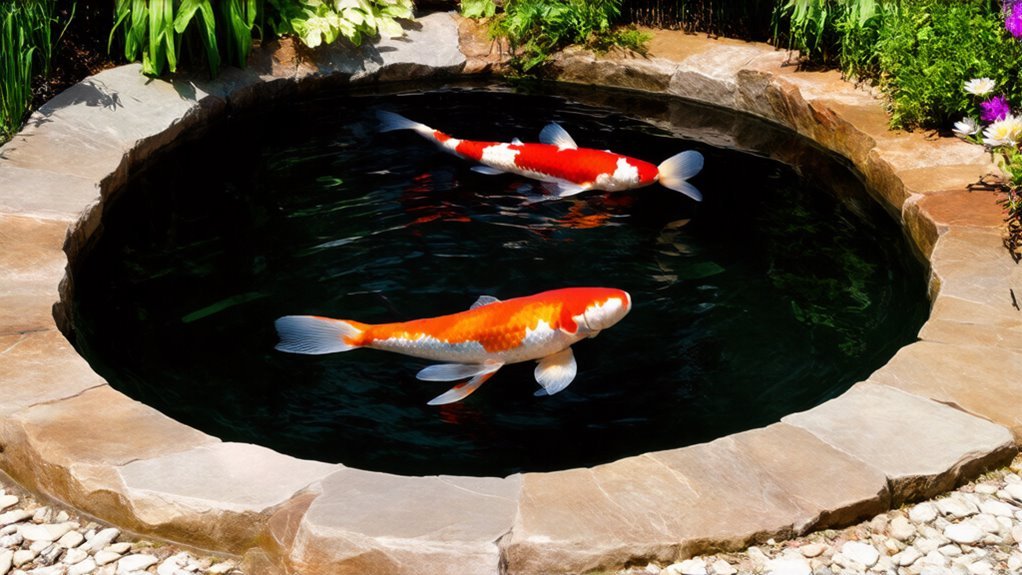Creating a fish pond requires careful planning, especially when selecting a liner. The right pond liner guarantees water stays where it belongs while keeping fish healthy. EPDM rubber liners typically last longer than PVC alternatives, though they cost more upfront. Experienced pond owners often prefer fish-safe materials that resist UV damage and punctures. The difference between a thriving aquatic ecosystem and constant maintenance headaches often comes down to this single component.
How to Choose the Right Fish Pond Liner for Your Needs

When selecting a fish pond liner, homeowners need to take into account several key factors to guarantee longevity and safety for aquatic life.
The most important consideration is pond liner materials. EPDM rubber liners offer durability and fish safety but cost more. PVC liners provide good flexibility at lower prices. LDPE liners balance cost and performance.
Choose your pond liner wisely—EPDM for quality, PVC for flexibility, or LDPE for balanced performance.
Match materials to fish pond requirements. Large koi need thick, puncture-resistant liners. For small goldfish, standard liners work fine. Always check if materials are labeled fish-safe to prevent chemical leaching. Additionally, consider environmental conditions to ensure the liner can withstand harsh weather and temperature extremes.
Measure accurately to avoid leaks and unnecessary expense.
EPDM vs. PVC Liners: Which Is Better for Fish Ponds?

Why do so many pond owners struggle with the choice between EPDM and PVC liners? The decision impacts fish health, maintenance needs, and overall pond durability for years to come.
EPDM advantages include:
- Superior UV resistance compared to PVC
- Longer lifespan of 20+ years in most conditions
- Fish-safe material with no toxic leaching
PVC drawbacks center on durability concerns. It tends to crack in cold weather and can become brittle with sun exposure.
While PVC costs less upfront and weighs less for easier installation, EPDM’s flexibility and puncture resistance make it the preferred choice for serious fish keepers. Additionally, using high-quality pond liners can significantly enhance longevity and minimize future leaks.
Top Pond Liner Brands for Fish Safety and Longevity

Top pond liner brands like Firestone and TotalPond offer fish-safe materials that won’t leach harmful chemicals into water.
Firestone EPDM stands out with its 45mm thickness and 20-year warranty, making it ideal for serious fish keepers.
TotalPond provides both premium rubber and PVC options with fish safety features.
For those seeking maximum fish protection, look for liners specifically labeled as fish-safe.
EPDM rubber liners generally outperform PVC for fish environments due to their non-toxic composition and durability in various temperatures. Additionally, consider eco-friendly liner alternatives that provide sustainable options for aquatic habitats.
Calculating the Perfect Pond Liner Size for Your Project
Before purchasing pond liner material, accurately calculating the right size is essential. Using proper liner measurement techniques guarantees water stays where it belongs. Remember, buying too small means starting over—a costly mistake.
To determine the correct liner size:
- Measure the maximum length and width of your pond.
- Add twice the maximum depth to each measurement.
- Add an extra 2 feet for overlap and secure anchoring.
Pond depth considerations affect both size and cost. Deeper ponds require more material but create better environments for fish. Additionally, it’s crucial to ensure that the liner is compatible with the pond construction materials used to prevent leaks.
Always measure at the pond’s deepest point for accuracy.
Essential Installation Tips for Fish-Safe Pond Liners
Installing a fish-safe pond liner correctly protects both your investment and aquatic life.
Begin by removing sharp objects from the excavated area. Place cushioning underlayment before positioning your liner to prevent punctures.
Allow the liner to warm in sunlight before installation to increase flexibility. Fit it loosely into the pond, avoiding stretching. Secure edges with heavy rocks while filling with water.
For a healthy fish habitat, rinse the liner thoroughly before adding water. Use installation materials like pond-safe glue for any seams.
Wait at least 72 hours after installation before introducing fish to guarantee chemicals have dissipated. Conduct regular inspections to identify any potential wear and tear that could affect the liner’s integrity.
Extending Your Pond Liner’s Lifespan: Maintenance Guide
A well-maintained pond liner can last decades beyond its warranty period with proper care. Regular liner cleaning prevents buildup of debris and algae that can degrade materials over time. This extends the life of EPDM, Butyl, and PVC liners alike.
Seasonal checks are essential for catching small issues before they become major problems. Look for:
- Tears or punctures in exposed liner areas
- Signs of UV damage like brittleness or color fading
- Shifting or sagging that might stress seams
Remove debris promptly and maintain proper water chemistry to prevent premature deterioration. Additionally, monitoring water levels regularly can help detect leaks early, ensuring that your liner remains in optimal condition.
With these simple practices, even budget liners can provide years of reliable service.
Eco-Friendly Pond Liner Options for Sustainable Fish Habitats
Environmentally conscious pond owners now have several green alternatives to traditional liners. EPDM rubber liners stand out as sustainable materials with longer lifespans than plastic options, reducing replacement frequency and environmental impact.
Some manufacturers now offer pond liners made from recycled materials or biodegradable components. When a liner reaches the end of its life, proper liner recycling through specialized facilities prevents it from ending up in landfills.
Natural clay liners provide another eco-friendly option for areas with suitable soil conditions. These create natural habitats that blend seamlessly with surrounding ecosystems while supporting healthy fish populations and native plant growth. Additionally, using eco-friendly liner options helps minimize plastic pollution and promotes sustainability in pond construction.
Frequently Asked Questions
Can Pond Liners Be Repaired if Damaged by Wildlife?
Pond liners damaged by wildlife can be repaired using specialized patch kits. Repair techniques vary by material type, with rubber liners typically being easier to mend than plastic varieties.
How Do Seasonal Temperature Changes Affect Different Pond Liner Materials?
Seasonal temperature changes affect pond liner materials differently. Rubber liners offer superior flexibility and durability in temperature fluctuations, while PVC and LDPE may become brittle in extreme cold, impacting their long-term material durability.
Are Some Pond Liners More Vulnerable to Root Penetration?
While trees silently plot their underground invasion, thinner liners stand little chance. Rubber liners like EPDM and Butyl offer superior root resistance compared to LDPE and PVC, with greater liner thickness providing additional protection.
Do I Need Permits to Install Larger Pond Liners?
Permit requirements for pond installations vary by location. Larger ponds typically require permits, especially those exceeding specific dimensions or involving significant excavation. Local authorities should be consulted before installation begins.
Can Liners Be Safely Used With Specialized Aquatic Plants?
Most pond liners are compatible with aquatic plants. Rubber liners (EPDM/Butyl) offer excellent aquatic plant compatibility. When considering liner material selection, choose fish-safe options without toxic chemicals.

